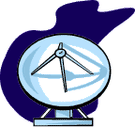Launching and Retrieving Satellites
Matthew D. / Physics #338 / 15 April 1997

Physics play a major role in the launching and retrieving of satellites.
The launching and retrieving of a satellite are the most important part
of a functioning satellite. Satellites are launched in many different ways
including the use of space shuttles and rockets. There are many different
ways of using the earth around you making it easier to launch a satellite,
for instance the use of equatorial and polar orbits. The forces found in
these orbits are also used for the re-entry of a satellite. Launching and
retrieving of satellites depends on many factors which make it useful in
the atmosphere.
Launching a Satellite
There are a variety of ways a satellite can be launched into orbit,
mainly two. Space shuttles carry some satellites into space, but most satellites
are launched by rockets that fall into the ocean after their fuel is spent.
Many satellites require minor adjustments of their orbit before they begin
to form their function. Built-in rockets called thrusters - some as small
as a mechanical pencil - make these adjustments. Once a satellite is placed
into orbit, it can remain there for a long period of time without further
adjustments. Many satellites, when launched, are projected into the earth's
atmosphere much like a space shuttle launched by NASA, except satellites
are launched mainly for the use of scientists.
To take advantage of the speed of the earth's rotation, satellites
are normally launched in a easterly direction. When they are launched into
polar orbits, which means to move in a direction from the North Pole to
the South Pole, their booster thrust must provide the whole orbital velocity.
Polar orbits have certain advantages. In time, because the earth is rotating
beneath it, the satellite will pass over its entire surface. In addition,
as in an equatorial orbit, the movement of direction from east to west
or vice versa. The satellite can be observed once in each revolution by
a single tracking station, in this case at one of the poles. Polar and
equatorial orbits help a satellite into orbit, using the earth's motion
to give the satellite a extra "boost" into the atmosphere.
Falling From Orbit
Without any plan of re-entry, a satellite has forces acting on it ,
causing it to return to earth on its own. A satellite remains in orbit
until its velocity decreases and the gravitational force pulls it down
into the relatively dense part of the atmosphere. A satellite slows down
due to the friction of air particles in the upper atmosphere and the gentle
pressure of the sun's energy. When the gravitational force pulls the satellite
down far enough, the air in front of it becomes so hot that most or all
of the satellite burns up. There is not always a definite chance a satellite
will make it back to the earth's surface in its entirety. It cannot with-stand
the pressure of the earth's atmospheric pressure during movement through
the orbit.
Re-entry of a Satellite
There are many elements which need to work for a satellite to return
successfully. When re-entering, "the satellite tends to lose velocity
faster and faster, because, as its apogee shortens, its ellipse loses more
and more of its eccentricity, approaching a circular orbit and passing
through perigee" (Jackson 202). Apogee is the point in the orbit of
the moon or of a artificial satellite where it is farthest from the earth.
Perigee is the exact opposite, it is the point nearest the earth. When
the ellipse finally degenerates into a circle, the atmosphere is dragging
continuously on the satellite. The perigee height becomes the apogee height,
and the two switch back and forth as the satellite spirals in through the
atmosphere.
" The satellite that broke free from the shuttle Columbia is to
plunge back to the earth's atmosphere as in expected to burn up completely
and not hit the ground. The fiery re-entry will be bright because of the
12 mile long tether dangling from the half- ton satellite" (NY Times
C5).
The launching and retrieving of satellites involves many aspects of
physics. These include the use of the earth itself and its motion as well
as the atmosphere surrounding it. As stated, a satellite does not have
to be launched or retrieved manually but can use the natural elements to
provide us with the information we are looking for.
References
Jackson, Joseph. Pictoral Guide to the Planets. New York: Cromwell
Company, 1973.
Oberright, John E. "Satellites, Artificial." World Book
Encyclopedia. CD-ROM.
Chicago: World, 1995.
"Satellite On Wire to Plunge Tonight." NY Times. 19
March 1996: Pg. C5.